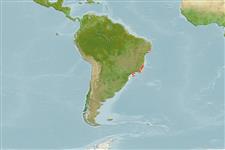Classification / Names
आम नाम | उपशब्द | Catalog of Fishes(वर्ग, प्रजाति) | ITIS | CoL | WoRMS | Cloffa
>
Eupercaria/misc (Various families in series Eupercaria) >
Labridae (Wrasses) > Corinae
Etymology: Halichoeres: Greek, als, alis = salt + Greek, choiros = pig (Ref. 45335); sazimai: Named for Dr. Ivan Sazima..
Environment: milieu / climate zone / depth range / distribution range
पारिस्थितिकी
समुद्री; गहराई सीमा 20 - 70 m (Ref. 80967). Tropical
Southwest Atlantic: Brazil.
आकार / वज़न / Age
Maturity: Lm ? range ? - ? cm
Max length : 21.4 cm SL पुल्लिंग / अलिंग; (Ref. 80967)
Short description
आकृति विज्ञान | मौरफोमैटरिक्स
पृष्ठीय रीढ़ (सम्पूर्ण): 9; पृष्ठीय सौफट रेज़ (सम्पूर्ण): 11; गुदा कांटा 3; ऐनल सौफट रेज़: 12; जानवरों की रीड़ का जोड़: 24. This specie sis distinguished by the following characters: D IX,11; A III,12; pectoral rays 13; caudal rays 14; lateral line scales 27; body y white with a stripe running on midline of the body from the snout, through the eye to tail; stripe straight, broadest and continuous from the snout to the shoulder, when it turns into a line of close-set spots in a zigzag pattern in alternate scales of 2 adjoining rows; terminal phase have the stripe entirely black or black at the first half becoming brownish, some with golden spots above and below scales, body darkened in the dorsum and the abdomen, becoming grayish or greenish in the area just above the mid-body stripe to the base of the dorsal fin; at the initial phase, the stripe is brown on the first third of its length and yellow to golden on the last two thirds (Ref. 80967).
Maximum depth from Ref. 126840. This species was observed foraging solitary on sand bottoms immediately adjacent to the lower end of rocky reefs. Harems that are composed of a few (5-10) individuals are not common but occasionally seen. This fish sometimes venture over the reefs, but generally never shallower than 20 m depth depending on water temperature (they seem to be associated with temperatures lower than 18°C). It also forages mostly on mobile invertebrates on soft and hard substratum, being more commonly observed foraging on sand bottoms and this behavior makes it a potential nuclear species in following associations, as it has been observed in other species of Halichoeres (Ref. 80967).
Life cycle and mating behavior
परिपक्व अवधि | पुनरुत्पत्ति | मछलीऔ का अंडे देना | अंडे | Fecundity | लार्वा
Distinct pairing during breeding (Ref. 205).
Luiz, O.J. Jr., C.E.L. Ferreira and L.A. Rocha, 2009. Halichoeres sazimai, a new species of wrasse (Perciformes: Labridae) from the Western South Atlantic. Zootaxa 2092:37-46. (Ref. 80967)
IUCN Red List Status (Ref. 130435)
Threat to humans
Harmless
Human uses
अधिक जानकारी
आम नामउपशब्दचपायचयपरभक्षीईकोटोकसीकोलौजीपुनरुत्पत्तिपरिपक्व अवधिमछलीऔ का अंडे देनाSpawning aggregationFecundityअंडेEgg development
Age/Sizeबाढ़Length-weightLength-lengthLength-frequenciesमौरफोमैटरिक्सआकृति विज्ञानलार्वालारवल गतिकीभर्तीबहुतायतBRUVS
संदर्भजलीयकृषिजलीयकृषि रूपरेखाखींचआनुवंशिकीElectrophoresesहैरेटिबिलटीबीमारीप्रक्रमणNutrientsMass conversion
सहयोगीयोतस्वीरेStamps, Coins Misc.ध्वनिसिगुयटिरारफ्तारतैरने के प्रकारगिल क्षेत्रOtolithsदिमागदृष्टि
साधन
Special reports
Download XML
इंटरनेट स्रोत
Estimates based on models
Preferred temperature (Ref.
123201): 21.6 - 27.2, mean 23.8 °C (based on 6 cells).
Phylogenetic diversity index (Ref.
82804): PD
50 = 0.5000 [Uniqueness, from 0.5 = low to 2.0 = high].
Bayesian length-weight: a=0.00955 (0.00451 - 0.02020), b=3.09 (2.92 - 3.26), in cm total length, based on LWR estimates for this Genus-body shape (Ref.
93245).
Trophic level (Ref.
69278): 3.6 ±0.5 se; based on size and trophs of closest relatives
लौटाव (Ref.
120179): माध्यम, न्यूनतम जनसंख्या दुगनी होने का समय 1.4 - 4.4 वर्ष। (Preliminary K or Fecundity.).
Fishing Vulnerability (Ref.
59153): Low vulnerability (16 of 100).
